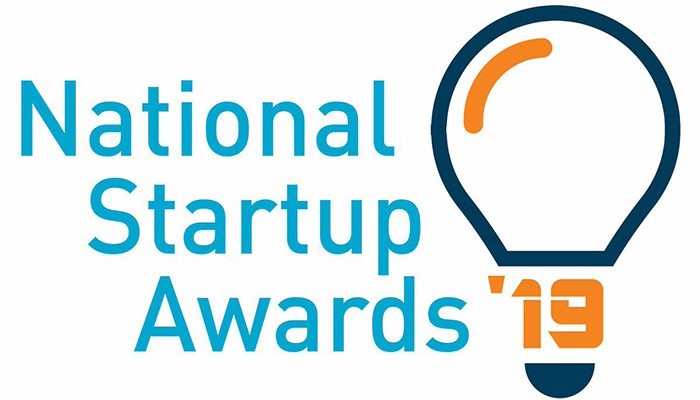
Gold in the Emerge-Tech Category!
24/08/2021It’s likely that your customers are very busy, especially if they are C-level executives. Organisational changes can have an impact on your sales leads, particularly those of a situational nature. For example, you might find that the decision-maker you were in negotiations with has left, or moved to a different role. If that’s not tough enough, you may also discover that the company doesn’t have the budget available, or they have already purchased a different service on an annual subscription base and can’t cancel it.
Don’t worry, this doesn’t mean that they don’t want your product. It just means that you have to wait until the decision-maker or budget is available, or when their annual subscription has finished. According to a Marketing Sherpa study, 73% of leads aren’t ready to buy when you first connect with them.
This means that B2B companies must find a way to nurture these sales leads until the buyer is ready to purchase the product/service. You need to keep them interested in what you’re doing. That way, when they are ready to buy, you are the top of mind brand and the first company they will want to call.
1. Lead nurturing definition
Lead nurturing is the process of developing relationships with buyers at every stage of the sales funnel and through every step of the buyer’s journey. It focuses marketing and sales on listening to the needs of prospects and providing the information and answers they need.
2. Benefits of lead nurturing
Here are some great statistics that support the lead nurturing process being critical to revenue:
- Companies that automate lead management see a 10% or greater increase in revenue in 6-9 months. (Gartner)
- Lead nurturing emails with good content generate an 8% CTR compared to general emails which generate just 3%. (HubSpot)
- Lead nurturing emails get 4-10 more response rate compared to single email blasts. (Demand Gen)
- Nurtured leads produce, on average, a 20% increase in sales opportunities as opposed to non-nurtured leads.(Demand Gen)
- Companies that excel during the lead nurturing process can generate 50% more sales leads and at 33% lower cost. (Forrester)
- Nurtured leads through email efforts make 47% larger purchases than non-nurtured leads. And at 33% lower cost. (Annuitas)
- Businesses that use marketing automation to nurture prospects experience a 451% increase in qualified leads. (Annuitas)
3. Lead nurturing process
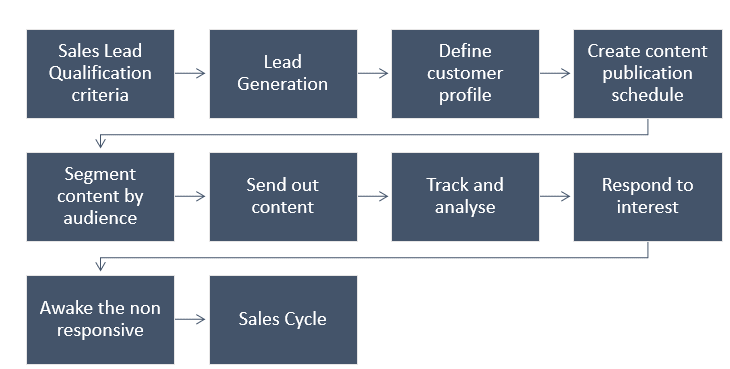
4. Sales lead qualification criteria
Normally, the ‘perfect customer’ possesses a number of key characteristics or attributes that will influence their likelihood to buy your product or service. Below are some examples of these attributes. These need to be agreed by Sales and Marketing, in order to determine which leads are best the fit for the product or service you’re selling:

5. Sales lead generation
Firstly, you should identify where your current sales leads are coming from. Usually, multiple sources (as outlined in the diagram below). Using the lead qualification criteria that we just discussed, you will need to analyse which of your existing sales lead sources will best fit the email campaign you’re developing.
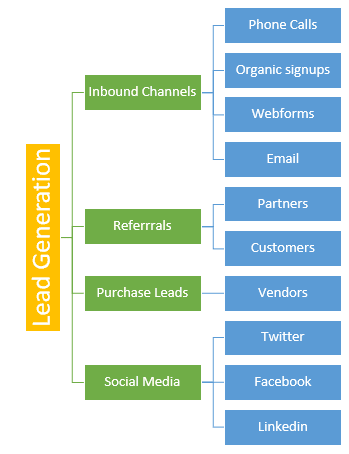
If you don’t have enough of the right sales leads in your CRM system or database today, you will need to set aside some budget to buy sales leads. Here are some great companies to consider:
- TAMI – tami.ai
- Unomy – unomy.com
- Hoovers – hoovers.com
- Insideview – insideview.com
- DiscoverOrg – discoverorg.com
- Found – found.ly
- Rainking – rainkingonline.com
- Datafox – datafox.com
- Elucify – getelucify.com
- Leadfeeder – leadfeeder.com
Now that you have your sales leads, you need to know your customer and develop the perfect customer profile.
6. Your customers’ needs and interests
To really understand your customers’ needs and interests, run a workshop between your Sales and Marketing teams. Here, you will most likely see different types of customers who have different needs and interests. Below is an example of one customer profile:
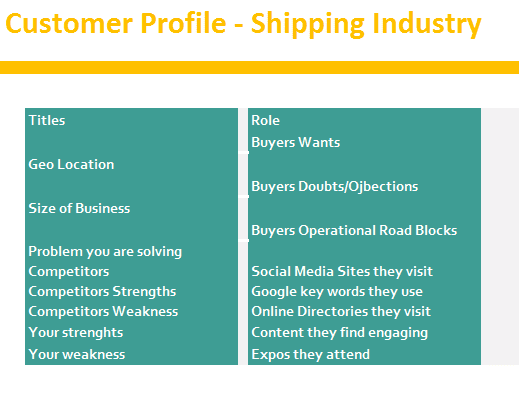
At TAMI for example, we provide sales leads to businesses selling to online retailers. Here are some examples of the industries we actively sell to:
- Shipping
- Fulfillment & Logistics
- Payment
- Banking Services
- Technology service providers
- Telecommunication companies
- Marketing & SEO agencies
- Fraud prevention software
- Online insurance providers
These industries provide services that can help online merchants with their business needs. For example: shipping and logistics for deliveries, payment and banking for transaction and funds handling, technology and software services to run websites and automate business tasks, marketing and SEO to help bring visitors to a website, and fraud and online insurance companies to help ensure that a merchant’s online business is as protected as any other business is on the high street.
This means that we have in excess of 20 customer profiles for different industries. As a result, we need to execute varying content strategies and sales pitches to ensure that the message is relevant for each customer profile.
Now that you’ve identified your customer profile, you can start sharing rich content with them. This will encourage interest and prompt them to view your website and get in touch.
7. Create engaging content
Keep buyers interested with original content that provides ideas and solutions to some of the pain points they are experiencing. This helps to educate your audience, not only about what you do but also that you are ‘the best’ at doing it.
There are a number of different ways you can engage with prospects through compelling content:
- Introduction email
- Follow up email after a customer has been on trial
- Case Studies
- How to guides
- Best practices
- Invitation to webinars
- Industry Whitepapers
- Newsletters
- Market reports
Three of the most common ways that companies segment their content includes: segmentation by market, buyer persona, and buying stage. 50% of companies create content for three or more market segments, and 47% support more than three buyer personas. 46% of companies create content supporting three or more buying stages in their market activities.
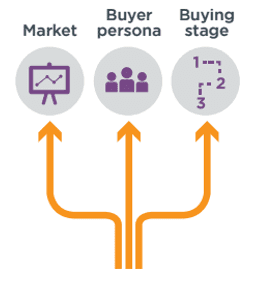
8. What kind of content is interesting?
Case studies are considered the most effective content subject, followed by best practices and how-to-guides. However, product features and competitive articles do not rank as highly on the list for compelling subjects to write about.
9. Develop a content schedule
Here’s an example of our content publication schedule. In this case, we reference the:
- Month
- Topic
- Market
- High volume traffic opportunities
- Our own channel
- What’s needed operationally
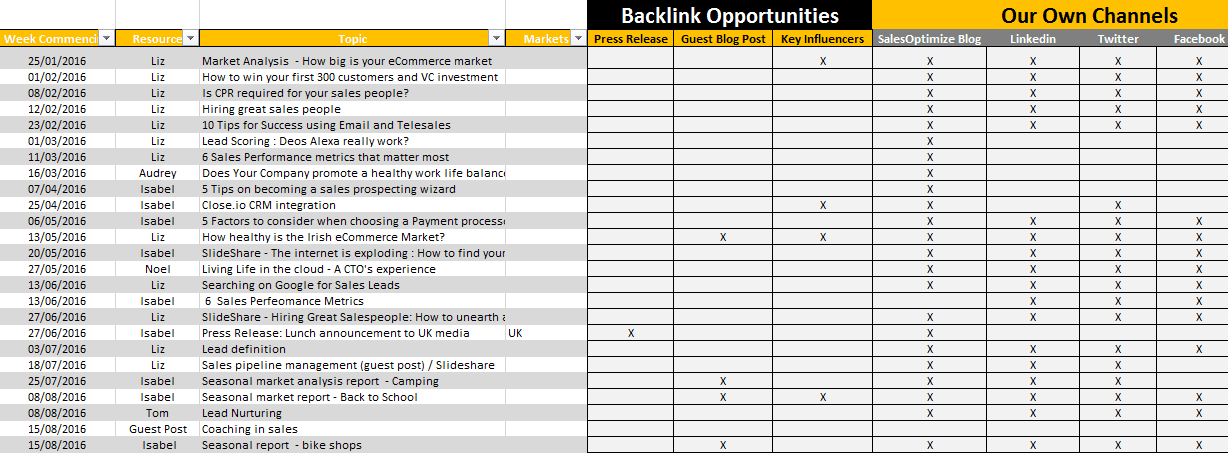
(A blog will be issued next month on how to develop a content publication schedule, as well as a marketing influence tracker).
10. Email marketing can communicate your message
Now that you have the leads, know who your ideal customer is, and you have engaging content, let’s start sending it out! I strongly recommend using an email marketing tool, and here are some great ones to consider:
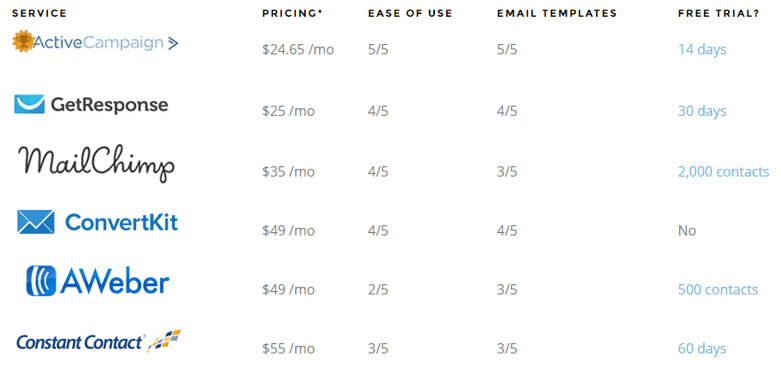
11. Track and analyse
After 48 hours, you can commence tracking and analysing the performance of the campaign. Typically, an open rate of 25% or above is considered good. 40% or more is considered excellent. Key KPIs to track on email marketing campaign are:
- Delivered email
- Open volume
- Open rate
- Click volume
- Click through rate
- Opt out rate
- Demos scheduled
- Demos done
- Trial sign up rates
- No of customers acquired
12. Respond to interest
One of the process steps we implemented in TAMI was to ring the customer immediately after they opened an email. If the customer was interested, we invited them to a product demo (for tips on how to execute a great sales demo, check out our blog post here) or a follow up meeting. We found this method to be very powerful, and it helped us acquire some large enterprise accounts within a few months of launching the business.
13. When customers fail to open emails
Awake the non responsive. Reasons why emails are not read can vary: they may have ended up in the spam folder, the target recipient has left the company, the email title or content was poor, etc. At this point, the marketing team should execute a follow up email. Where the customer has failed to open both the original and follow up email, it may be a good idea to arrange for an outbound sales executive to start working their magic!
14. Summary
Lead Nurturing is hard work and requires a commitment of resources and budget. It’s an incredible journey and a critical process that drives double digit growth in your bottom line. After each campaign, sit down with the Sales and Marketing teams and discuss what worked and what didn’t; don’t be afraid to have frank discussions. These will give you incredible moment of truths that may lead to improvements in your product, your lead qualification criteria, your customer profile definition, your email content, sales follow up process, and ultimately your bottom line.
————
If you want to know more about lead nurturing, lead generation, lead scoring, or other sales/marketing activities, please don’t hesitate to contact me. I would love to chat more about this, and I’m always open to different ideas and viewpoints: liz.fulham@tami.ai, CEO for TAMI






